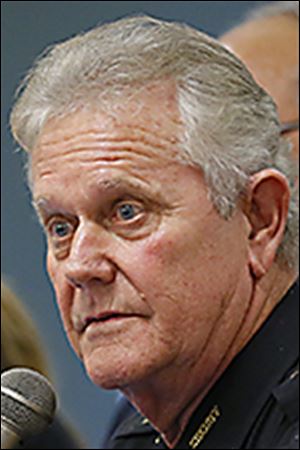
EDITORIAL
Addiction model
7/21/2014
Tharp
Ohio’s opioid and heroin epidemic is challenging local law enforcement agencies across the state to change how they do business — and is requiring communities to come together to battle addiction. A new initiative by Lucas County Sheriff John Tharp provides a model for the state, and the nation, on how to do it.
The department’s new four-person Addiction Resource Unit includes two deputies who work full-time investigating overdoses and working with overdose victims and their families to get people into treatment.
A conference last week announcing the initiative was attended by dozens of treatment providers, as well as local police chiefs, other representatives of law enforcement, elected officials, and the county coroner’s and prosecutor’s office. Seldom have cops and treatment workers been so united in a common cause.
But this is no time for business as usual, as Sheriff Tharp has said repeatedly. Heroin-related deaths in the Toledo area more than doubled last year — to 80, from 31 in 2012. Such deaths are on pace nearly to double again this year. The coroner’s office was conducting an autopsy on an overdose victim when the conference presenting the initiative occurred.
And overdoses alone don’t begin to measure the misery endured by thousands of local people who are addicted to heroin and prescription painkillers, or the hurt, confusion, and loss they cause their families and friends.
By getting directly involved with treatment and supporting addicts and their families, the new Addiction Resource Unit is changing how law enforcement reacts to one of the state’s biggest public health problems. Until recently, law enforcement treated fatal and nonfatal drug overdoses casually — almost callously — as accidents, with little or no investigation or follow-up.
By contrast, addiction resource officers will meet family members at hospitals in nonfatal overdose cases and conduct follow-up interviews at their homes. They will also work with families of addicts who have had trouble with the law, mostly by stealing to support their habits, but are now seeking help.
Local 911 dispatchers now notify the sheriff’s office of every overdose. As first responders, law enforcement officers are in a good position to help.
Sheriff’s deputies will work with local treatment and prevention agencies, including A Renewed Mind and Awake. In a delicate dual role, they’ll also work with the Metro Drug Task Force to investigate dealers.
“Our whole way of doing business has to change,” Mr. Tharp told The Blade’s editorial page. “This is not a program — it’s not a philosophy. This is the way we’re going to do business from here on out.”
Lucas County commissioners should be commended for supporting the initiative. Sheriff Tharp had no money set aside to start the unit. Nor did he want to wait months for a grant. With the commissioners’ blessing, he filled the new positions with deputies already on staff, covering their former duties with added overtime pay for other officers.
The Toledo Police Department and county prosecutor’s office are also working with the new unit. Mr. Tharp is talking with other law enforcement agencies and treatment providers about donating a few hours a week for this important work. Help can’t come too quickly: The new unit already has 60 cases and needs more staff.
Lucas County can take pride in what’s happening here. What started as a sheriff’s office initiative has become a true community effort that counties around the state should emulate. Coping with this insidious epidemic will require nothing less.